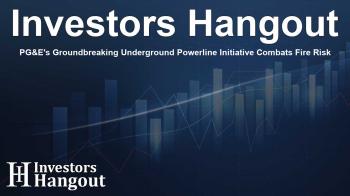PG&E's Groundbreaking Underground Powerline Initiative Combats Fire Risk

PG&E's Efforts to Combat Wildfire Risks
Pacific Gas and Electric Company (PG&E) has now successfully constructed and energized 1,000 miles of powerlines underground aimed at reducing wildfire risks across high fire risk areas. This initiative has been labeled as the most extensive undergrounding effort ever undertaken by a utility for wildfire mitigation. By burying these lines, PG&E has nearly eliminated the wildfire risk in areas where they operate.
As part of a broader system hardening strategy, PG&E's undergrounding project has played a significant role in reducing wildfire ignition risk by 8.4% since 2023. This achievement exemplifies the company's commitment to enhancing safety for its customers.
The Distance of 1,000 Miles
To put the distance of 1,000 miles into perspective, one could travel from the Oregon-California border to the California-Mexico border, covering approximately 932 miles. This information underscores just how remarkable this accomplishment is for PG&E.
Peter Kenny, PG&E's senior vice president of Electric Operations, expressed pride in this milestone: "When our CEO, Patti Poppe, announced that we would place thousands of miles of powerlines underground in 2021, many doubted our capability. Today, we celebrate reaching 1,000 miles and beyond, while also reducing costs significantly for our customers as we scale our efforts."
Underground Powerlines Across California
The underground powerlines now serve customers in 27 counties across Northern and Central California, with notable distances including 337 miles in Butte County and 119 miles in Shasta County. Additionally, each of El Dorado, Lake, Placer, Plumas, and Solano counties also have more than 50 miles of buried powerlines.
PG&E projects that by the end of 2026, they will have a total of 1,600 miles of underground powerlines, achieving an impressive total risk reduction of 18% across their entire system.
Cost Reduction Through Innovation
Since the inception of this undergrounding initiative, the cost per mile has decreased from $4 million to $3.1 million in 2025, indicating ongoing efficiencies. PG&E attributes these savings to several innovative practices:
- Supporting local economies by hiring community contractors, which also cuts travel expenses.
- Utilizing state-of-the-art construction equipment such as chain trenchers and rock-wheel saws for enhanced efficiency.
- Eliminating the repetitive tree trimming needed for overhead line maintenance.
- Streamlining processes by reducing the standard depth and width of trenches.
- Using excess soil from undergrounding projects to minimize disposal costs on operational projects.
Prioritizing Community Safety Amid Rising Fire Risks
As fire risks continue to escalate throughout the western United States, PG&E is focused on implementing both immediate measures and long-term plans to safeguard communities. Their multi-layered protection strategy is designed to prevent wildfires effectively. The comprehensive safety measures have notably averted significant fires caused by their equipment in recent years while also vastly lowering wildfire risks since 2018.
In the past seven years, PG&E has:
- Established a statewide network of almost 1,600 weather stations and over 650 HD cameras to monitor wildfire risks in real-time.
- Conducted inspections, trimming, or removal of over 960,000 trees and vegetation across their service area.
- Completed more than 1,000 miles of undergrounding to mitigate fire hazards.
- Installed upwards of 1,400 miles of reinforced power poles and secured powerlines.
Leadership's Vision for the Future
Matt Pender, PG&E's vice president of Undergrounding and System Hardening, expressed his enthusiasm for the project. He stated, "It feels amazing to be making a difference that will last for decades by placing these lines underground and significantly reducing wildfire risk in the long term."
In a recent report from the Stanford Woods Institute, PG&E was acknowledged as one of the nation's leading utilities for wildfire preparedness. Their Wildfire Mitigation Plan has achieved Tier 1 maturity, marking the highest possible score in evaluation.
Frequently Asked Questions
What does PG&E's underground powerline project aim to achieve?
The project aims to reduce wildfire risks significantly by burying powerlines in high-risk areas, with a goal to achieve a total risk reduction of 18% across the system.
How many miles of powerlines has PG&E put underground?
PG&E has successfully constructed and energized 1,000 miles of underground powerlines to date and aims for 1,600 miles by the end of 2026.
What has been the financial impact of the undergrounding project?
Costs per mile of undergrounding have decreased from $4 million to $3.1 million, indicating significant efficiencies through innovative practices.
In how many counties are PG&E's underground powerlines operating?
There are underground powerlines serving customers in 27 counties across Northern and Central California.
How has PG&E improved its wildfire response efforts?
PG&E has implemented a statewide network of weather stations and cameras, conducted inspections and tree removals, and installed stronger power infrastructure to enhance wildfire response capabilities.
About The Author
Contact Hannah Lewis privately here. Or send an email with ATTN: Hannah Lewis as the subject to contact@investorshangout.com.
About Investors Hangout
Investors Hangout is a leading online stock forum for financial discussion and learning, offering a wide range of free tools and resources. It draws in traders of all levels, who exchange market knowledge, investigate trading tactics, and keep an eye on industry developments in real time. Featuring financial articles, stock message boards, quotes, charts, company profiles, and live news updates. Through cooperative learning and a wealth of informational resources, it helps users from novices creating their first portfolios to experts honing their techniques. Join Investors Hangout today: https://investorshangout.com/
The content of this article is based on factual, publicly available information and does not represent legal, financial, or investment advice. Investors Hangout does not offer financial advice, and the author is not a licensed financial advisor. Consult a qualified advisor before making any financial or investment decisions based on this article. This article should not be considered advice to purchase, sell, or hold any securities or other investments. If any of the material provided here is inaccurate, please contact us for corrections.

